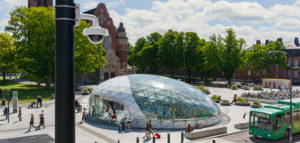Delivering dependable technology today, for tomorrow’s smart cities
Cities are in constant flux, with authorities expected to develop them to provide a high quality of life for their citizens. At the same time, those authorities must be prepared for future trends such as increased urbanization.
Cities are using technology and data to analyze, prioritize, make decisions and use resources as efficiently as possible. However, long-term trends and priorities can quickly change based on unpredictable situations and events. A pandemic, an incident, or a natural disaster might change how citizens act and behave, and the authorities rely on tools that are flexible and adaptable to handle situations that arise.
Technology will always be a key enabler for cities in their quest to become smart. Of the many technologies deployed in cities, surveillance systems play a key role, acting as the eyes and ears of city authorities across all aspects of urban life.
Smarter cities with flexible, scalable solutions
Safety is one of the key responsibilities of every city – feeling safe and secure is one of the main rights of any citizen, but it’s not the only factor to consider when ensuring delivery of effective smart city projects. With new challenges, we must move away from the traditional operating model where city departments work in silos, focusing only on one area of operation, such as traffic or health.
A network camera, for example, might be primarily used for video surveillance to improve public safety, but it can also be a tool for gathering data and statistics for traffic management and environmental monitoring. During the pandemic surveillance systems have, with limited reconfiguration, been adapted to monitor social distancing, and integrated horn-speakers have been used for communicating guidance and information about new regulations.
Solutions built on open standards are flexible, scalable and straightforward to integrate. A single device can, with its open technology, break down data silos and support several use cases and goals of multiple city authorities. Through open platforms such as AXIS Camera Application Platform (ACAP), partners can develop applications for network cameras that allow cities across the world to meet their needs and objectives.
Advanced features support city officials
Cities are some of the more complex environments for camera deployment, particularly when it comes to obtaining actionable, good quality images. Objects and people in motion, changing light and weather conditions can all present a real challenge for obtaining reliable data.
Specific technologies have been developed to address these challenges in city-wide deployments. Some examples are Lightfinder and Wide Dynamic Range technology, which manage difficult low light or backlight conditions, as well as electronic image stabilization that minimizes the effects from vibration and shaking from wind or traffic. These features ensure that images captured are consistently high quality, irrespective of the environment.
Product and image quality are crucial for securing a future-proof solution. A camera that was deployed for a basic surveillance or a specific use-case might be required in future to handle applications such as crowd management with people constantly in motion.
Surveillance cameras are becoming increasingly intelligent sensors. Particularly when using deep learning-based edge analytics the power of video surveillance is multiplied. Such analytics can potentially “foresee” where critical or violent situations are about to arise, triggering messages or warnings via network audio speakers to diffuse situations. Alongside these, security personnel or law enforcement can be alerted to monitor the situation and intervene if necessary.
Improved urban mobility today, safer cities tomorrow
Even in the absence of specific incidents, overcrowding brings its own challenges in city environments. On transportation or in public spaces, crowd management is an important priority for safety – particularly with the need for increased social distancing. Unfortunately, we’re beginning to understand that these will be ongoing requirements rather than a short-term need.
Network video solutions, combined with analytics, can help monitor the movement and distance between people in a specific area, for example, a public festival. Should an area get overcrowded or guidance be ignored, the system generates warnings and statistics for further action.
Overcrowding isn’t just limited to people. The effective management of traffic is necessary – especially in densely populated cities. Flexible video surveillance can play a central role in helping to optimize traffic flows and increase safety, especially when the number or type of vehicles on the road changes.
Surveillance technology in combination with video analytics using artificial intelligence (AI) or deep learning, can not only help monitor the roads, but provides a more predictive view. This helps traffic management centers (TMCs) plan and manage traffic in real time, aiding officials in preventing bottlenecks and subsequent congestion. Advanced AI software can also be added to improve the distinction between vehicles, people and objects, to detect potential incidents or accident risk. This becomes even more important if there is an increase in cyclists and pedestrians.
City mobility must change according to citizens’ needs
Transportation needs in smart cities are shifting. Citizens want greener, safer and more innovative infrastructure to improve livability. The current pandemic, for example, has led to many people avoiding public transport to reduce the risk of infection. The result has been a rapid shift to walking and cycling, leading cities such as Paris and Munich to change aspects of street layouts. For example, cycle lanes were introduced on busy streets to mitigate the risks of cyclists, cars, vans and trucks mixing in the same space.
Analyzing data from video-based traffic management solutions can help authorities spot these trends faster, allowing for authorities to implement safety measures, divert traffic or change road layouts. Temporary short-term demands can lead to sustained changes long-term, benefiting both citizens and the environment.
Supporting the sustainable cities of tomorrow
Sustainability will always be a key priority and will touch every process within a city. Any solution implemented must use products from a sustainable supply chain, that are built with environmentally friendly materials. Operators, distributors and end-customers should also ensure to deploy high quality products, as these are likely to last longer. Ultimately, the need for future repair and replacement will be reduced.
Smart city surveillance solutions based on open architectures also contribute to sustainability goals, allowing authorities to combine products from different partners and various hardware and sensors. This flexibility supports an approach which has a long-term view, as legacy systems can be upgraded instead of being replaced, and investments can be made in the knowledge that they support future enhancement.
Getting smart cities ready for the future
Connected video surveillance systems are already used in numerous ways to increase safety and security in cities. But it’s crucial to understand the value of investing in advanced, open systems that allow for devices, sensors and software to be added to the network. This will make it easy for solutions to be optimized to address both existing and new use-cases. Axis remains committed to developing innovative solutions that will put smart cities in an optimal position to evolve and address future demands and challenges – unexpected or otherwise.
Find out more about Axis solutions for smart cities.




